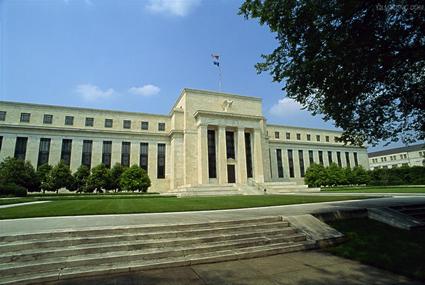ZHOU Hao/LIN Ketong
Monetary PolicyFinancial Stability Research Center
PBC School of Finance, Tsinghua University
Following a two-day meeting of the Federal Open Market Committee (FOMC), the Federal Reserve released a statement on Wednesday (June 19) announcing that it would purchase bonds worth $85 billion monthly, including long-term government bonds worth $45 billionmortgage-backed securities worth $40 billion. Meanwhile, the federal funds rate is expected to remain at an extremely low level of between 00.25 percent to further stimulate employment growtheconomic recovery.
At the press conference that followed the day’s regular meeting, Bernanke stated that risk to the US economythe US job market has fallen since last autumnthat against the backdrop of high unemploymentcontrollable inflationary pressure, the Fed’s loose monetary policy will continue for a period of time. The Fed will dynamically adjust the scale of its assets purchase plan according to changes in the economic situationthe US nonfarm unemployment rate is expected toto some 7 percent by the middle of the next year, about 1 percent lower than the unemployment rate recorded in September 2012 when QE3 was launched. If US economic trends match the expectations of the Fed, sustained by new jobs, the US economy is expected to see stable growth,the Fed will gradually downsize QE3 later this year until terminating it in the middle part of next year. This is the Fed’s first formal plan framework on the winding down of QE3 as well as the first time that Bernanke has clearly indicated the threshold for QE3 winding down—an unemployment rate of 7 percent.
Bernanke also stressed that the vast majority of the Fed’s senior officials tend towards believing that the balance sheet of the central bank should be primarily composed of US government bonds in the long run, but mortgage-backed securities should not be temporarily sold during the process in which the Fed’s monetary policy returns to normal. The Fed does not seek to reduce the scale of its balance sheet, though it is slowing down the rate of increases on this balance sheet. This suggests that there is still a long way to go for the central bank to truly wind up QE3.

Headquarters of the Federal Reserve
Has the Fed begun the orderly winding down of QE3? Just how much farther is it from winding down QE3? Will the road ahead be smooth? Will global financial markets suffer greater effects?
We believe that the Federal Reserve’s policy for winding down QE actually came into effect during the second quarter of this year. This judgment is based on our recognition of the operation mode of the Fed’s monetary policy. Since the 1990s, federal monetary policy has been implemented according to announcements released by meetings of the FOMC: first, the federal fund rate is adjusted to influence short-term ratesentire yield curves, thereby achieving monetary policy goals; second, announcements of future policy inclinations are made so as to influence market expectations, thereby influencing long-term rates.
The meeting announcementpress conference that followed the June 19 FOMC meeting are precisely intended to give indications of future policy inclinations. Thus, based on our understanding of the operation mode of federal monetary policy, we can judge that the Fed is sending a clear signal of the orderly winding down of QE3. This also tallies with some information disclosed intentionallyunintentionally by the central bank between AprilJune of this year, such as Bernanke's public speech on May 22, the FOMC meeting announcement disclosing that policy inclination would gradually shift from looseness to neutrality,the earlier disclosure of the minutes of the April 10 Fed meeting. It seems today that all these things have paved the way for the release of the June 19 announcement.
On the other hand, the Fed’s orderly winding down of QE policy meets the needs of the US economy’s US real economic operationfinancial stability oversight. This time, the central bank updated its outlook for the future economy, raising expected economic growth for 2014 to 3.25 percent, far above market expectations. Consequently, this is the right time for the Fed to consider winding down QE3. Additionally, QE3 has not significantly alleviated structural unemployment. On the contrary, it has brought about great excess liquidityoverheating in some real estate markets that is even worse than what was seen at the peak of the 2004-2007 US real estate boom. If QE continues, unemployment is not certain to decrease significantly,on the contrary, more unstable factors could be added to the financial markets.
In the aftermath of the release of the Fed’s Wednesday meeting announcement, Thursday saw global stock markets plungeprices of gold, silver,crude oil futures plummet. Many worry that the Fed’s further winding down of QE3 will make global financial markets more turbulent. We believe that it is possible that financial markets might not experience any stronger reactions. Generally speaking, markets are most uncertain right before the Fed unveils policies, but they are calm when policies are officially rolled out due to the markets already having adjusted previously. Additionally, the Fed’s winding down of QE3 signals the recovery of the US economycan boost market confidence. Though the bond market is likely to be influenced negatively, this is good news for the market in the long run.
In summary, the release of the FOMC’s meeting announcementthe press conference that followed the meeting on June 19 indicate that the policy of winding down QE has come into effect,this tallies exactly with the information on market expectations disclosed by the central bank during the second quarter of this year. This is also good news for the economy. Influenced by policy expectations, the market will fluctuate significantly in the near term, but in the long run, it is possible that the official release of QE exit policy might not provoke turbulence in the financial markets.

PBC School of Finance, Tsinghua University